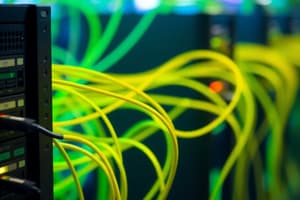Podcast
Questions and Answers
What is the primary benefit of increased connectivity in society?
What is the primary benefit of increased connectivity in society?
- Increased productivity in business (correct)
- Reduced reliance on technology
- Greater isolation among individuals
- Decreased productivity in business
Which type of network is specifically designed for a small geographic area, like a home or office?
Which type of network is specifically designed for a small geographic area, like a home or office?
- Local area network (correct)
- Personal area network
- Metropolitan area network
- Wide area network
What is a key distinguishing feature of cellular communication compared to dial-up and DSL?
What is a key distinguishing feature of cellular communication compared to dial-up and DSL?
- Uses physical wires for data transmission
- Requires a home telephone line
- Provides internet via satellite connection
- Operates wirelessly (correct)
Which factor is considered critical for data transmission within networks?
Which factor is considered critical for data transmission within networks?
What type of communication channel does not use physical connections, typically relying on airwaves?
What type of communication channel does not use physical connections, typically relying on airwaves?
What is the primary function of a firewall in network security?
What is the primary function of a firewall in network security?
Which of the following statements accurately describes an intranet?
Which of the following statements accurately describes an intranet?
How does a Virtual Private Network (VPN) enhance network security?
How does a Virtual Private Network (VPN) enhance network security?
In a Peer-to-Peer (P2P) network, what is true about the authority of the nodes?
In a Peer-to-Peer (P2P) network, what is true about the authority of the nodes?
What is the role of a Network Administrator?
What is the role of a Network Administrator?
What is a key requirement for candidates seeking positions in networking hardware and software?
What is a key requirement for candidates seeking positions in networking hardware and software?
Which of the following best describes telepresence technology?
Which of the following best describes telepresence technology?
What is typically preferred for candidates in network roles?
What is typically preferred for candidates in network roles?
What is one potential advantage of telepresence technology?
What is one potential advantage of telepresence technology?
Which of these network types is focused on small geographical areas, like a single building?
Which of these network types is focused on small geographical areas, like a single building?
The annual salary for networking professionals typically ranges between which amounts?
The annual salary for networking professionals typically ranges between which amounts?
Which of the following describes a network topology where each node is connected to a central hub?
Which of the following describes a network topology where each node is connected to a central hub?
Which protocol is concerned with the process of converting a human-readable domain name into an IP address?
Which protocol is concerned with the process of converting a human-readable domain name into an IP address?
What is the maximum data rate of Wi-Fi 5?
What is the maximum data rate of Wi-Fi 5?
Which type of cable has a higher transmission capacity than twisted pair cables?
Which type of cable has a higher transmission capacity than twisted pair cables?
What is the primary function of a modem?
What is the primary function of a modem?
What frequency does Wi-Fi 6E utilize?
What frequency does Wi-Fi 6E utilize?
Which technology is used to determine the geographic location of devices?
Which technology is used to determine the geographic location of devices?
What is the main advantage of fiber-optic cables over coaxial cables?
What is the main advantage of fiber-optic cables over coaxial cables?
Which of the following is not a type of physical connection medium?
Which of the following is not a type of physical connection medium?
What is the unique identifier for each computer on a TCP/IP network?
What is the unique identifier for each computer on a TCP/IP network?
Which of the following is an example of a wireless technology?
Which of the following is an example of a wireless technology?
What is the purpose of packetization in data transmission?
What is the purpose of packetization in data transmission?
Which connection service is known for using multiple antennae for communication?
Which connection service is known for using multiple antennae for communication?
Which of the following describes a client in a client/server network?
Which of the following describes a client in a client/server network?
What is the main characteristic of broadband connections?
What is the main characteristic of broadband connections?
What are the basic elements of communication systems?
What are the basic elements of communication systems?
Which of the following is NOT an application that depends on communication systems?
Which of the following is NOT an application that depends on communication systems?
What significant change in connectivity has occurred in the past decade?
What significant change in connectivity has occurred in the past decade?
What materials do wireless connections utilize for communication?
What materials do wireless connections utilize for communication?
Which component acts as the interface between sending and receiving devices in a communication system?
Which component acts as the interface between sending and receiving devices in a communication system?
In a communication system, which of the following describes the rules and procedures that coordinate the devices?
In a communication system, which of the following describes the rules and procedures that coordinate the devices?
What is the primary function of communication channels?
What is the primary function of communication channels?
Which of the following best describes computer communications?
Which of the following best describes computer communications?
Flashcards
Connectivity
Connectivity
The ability of devices to communicate with each other.
Wireless Revolution
Wireless Revolution
The rapid growth of wireless communication technologies.
Communication Systems
Communication Systems
The infrastructure that enables communication between devices.
Data Transmission Factors
Data Transmission Factors
Signup and view all the flashcards
Networks
Networks
Signup and view all the flashcards
Computer Communication
Computer Communication
Signup and view all the flashcards
Basic Elements of Communication
Basic Elements of Communication
Signup and view all the flashcards
Sending/Receiving Devices
Sending/Receiving Devices
Signup and view all the flashcards
Connection Devices
Connection Devices
Signup and view all the flashcards
Communication Channel
Communication Channel
Signup and view all the flashcards
Data Transmission Specifications
Data Transmission Specifications
Signup and view all the flashcards
Server OS
Server OS
Signup and view all the flashcards
Peer-to-Peer Network
Peer-to-Peer Network
Signup and view all the flashcards
Intranet
Intranet
Signup and view all the flashcards
Extranet
Extranet
Signup and view all the flashcards
Firewall
Firewall
Signup and view all the flashcards
Network Administrator
Network Administrator
Signup and view all the flashcards
Network Security
Network Security
Signup and view all the flashcards
Telepresence
Telepresence
Signup and view all the flashcards
Data Transmission Bandwidth
Data Transmission Bandwidth
Signup and view all the flashcards
Network Topology
Network Topology
Signup and view all the flashcards
Network Security Strategies
Network Security Strategies
Signup and view all the flashcards
Radio Waves
Radio Waves
Signup and view all the flashcards
What are the primary wireless connection technologies?
What are the primary wireless connection technologies?
Signup and view all the flashcards
Wi-Fi 1
Wi-Fi 1
Signup and view all the flashcards
Wi-Fi 2
Wi-Fi 2
Signup and view all the flashcards
Twisted Pair Cable
Twisted Pair Cable
Signup and view all the flashcards
Coaxial Cable
Coaxial Cable
Signup and view all the flashcards
Fiber-optic Cable
Fiber-optic Cable
Signup and view all the flashcards
Bluetooth
Bluetooth
Signup and view all the flashcards
Wi-Fi
Wi-Fi
Signup and view all the flashcards
Microwave
Microwave
Signup and view all the flashcards
WiMax
WiMax
Signup and view all the flashcards
Modem
Modem
Signup and view all the flashcards
Digital Subscriber Line (DSL)
Digital Subscriber Line (DSL)
Signup and view all the flashcards
Leased Lines
Leased Lines
Signup and view all the flashcards
Bandwidth
Bandwidth
Signup and view all the flashcards
Protocols
Protocols
Signup and view all the flashcards
Study Notes
Learning Objectives
- Explain connectivity, the wireless revolution, and communication systems
- Describe physical and wireless communications channels
- Differentiate between connection devices and services
- Describe data transmission factors, including bandwidth and protocols
- Define networks and key network terminology
- Describe different types of networks
- Describe network architectures, including topologies and strategies
- Explain organization issues related to Internet technologies and network security
Introduction
- We live in a truly connected society
- Increased connectivity potentially means increased productivity, especially in business
- Students will learn about connectivity and the impact of the wireless revolution
Communication
- Computer communications is the process of sharing data, programs, and information between two or more computers
- Numerous applications depend on communication systems, including texting, email, videoconferencing, and electronic commerce
Connectivity
- Connectivity uses computer networks to link people and resources
- Connects personal computers to other computers and resources on a network and the Internet
- Wireless revolution is the single most dramatic change in connectivity in the past decade
- Allows individuals to connect to the Internet and share information from almost anywhere in the world
Communication Systems
- Communication systems are electronic systems that transmit data from one location to another
- Wired or wireless, every communication system has four basic elements: sending device, message, connection device, communication channel, connection device, message, receiving device, and packets
Basic Elements of Communication
- Sending and receiving devices (computer or specialized communication device)
- Connection devices (interface between sending and receiving device)
- Data transmission specifications (rules and procedures that coordinate the devices)
- Communication channel (carries the message)
Communication Channels
- Physical connections using wire or cable
- Wireless connections
Wireless Connections
- Wireless connections do not use a solid substance to connect, primarily using radio waves
- Primary wireless technologies are cellular, Bluetooth, Wi-Fi, microwave, WiMax, and satellite connections
- Key Wi-Fi alliance and IEEE standards and their maximum data rates are provided in table format
Physical Connections
- Physical connection uses solid medium to connect between sending and receiving devices
- Twisted pair cable: two pairs of copper wire twisted together (telephone lines, Ethernet cables)
- Coaxial cable: single solid copper core (Cable TV)
- Fiber-optic cable: tiny glass tubes
Primary Wireless Technology
- Bluetooth (short-range) – radio communication standard
- Wi-Fi (wireless fidelity) – uses high-frequency radio waves
- Microwave – uses high-frequency radio waves
- WiMax (extends Wi-Fi) – new standard that extends Wi-Fi range using microwave
- Cellular – use multiple antennae for communication
- Satellite – uses satellites as microwave relay stations
- Infrared - Uses infrared light for communication over short distances
- GPS – determines geographic location of devices
Connection Device Signals
- Types of signals (analog, digital)
- Transfer rates (Mbps – million bits per second, Gbps – billion bits per second, Tbps – trillion bits per second)
Connection Devices
- Modem – modulator-demodulator
- Modulation – converting digital to analog
- Demodulation – converting analog to digital
- Transfer rate – speed of data transfer, usually measured in megabits per second (Mbps)
Types of Modems
- Digital Subscriber Line (DSL) – high-speed telephone lines
- Cable – uses coaxial cable
- Wireless – also known as WWAN
Connection Services
- Leased lines (T1 combined to form T3 and DS3, replaced by OC lines, faster optical carrier lines, higher capacity, not affordable for individuals)
- DSL (uses phone lines, increasingly ADSL most commonly used)
- Cable (uses existing TV cable, faster than DSL)
- Other Connection Services
Network Types
- LAN (Local Area Network) - located within close proximity
- Home - Local area network for home use, usually wireless (WLAN)
- Wireless Local Area Network (WLAN) - wireless local area network, communication passes through an access point
- Personal Area Network (PAN) - connects digital devices
- Metropolitan Area Network (MAN) - typically spans cities, coverage up to 100 miles
- Wide Area Network (WAN) - countrywide or worldwide coverage
Network Architecture
- How the network is arranged and resources are shared
- Network Topology – physical arrangement of the network
- Network Strategy – How the information and resources are shared
- Key network topologies including ring, star, tree, and mesh
Network Strategies
- Client/Server Network – Central computers coordinate and supply services, server provides access, client requests services, typical server OS ex. Windows Server, macOS X Server, Linux, and Solaris
- Peer-to-Peer (P2P) Network – All nodes have equal authority, can act both as client and server
Organizational Networks
- Intranet – private network within an organization, works like the internet
- Extranet – private network that connects more than one organization, works like internet with limited access for trusted partners
Network Security
- Firewall – hardware/software controls access to a network
- Proxy server – provides pass-through access, protects against external threats
- Intrusion Detection System (IDS) – Works with firewall to protect organization's network, analyzes incoming/outgoing network traffic
- Virtual Private Network (VPN) – creates secure private network between user computer and the organization
Network Security Graphic
- Diagram of intranet, extranet, and proxy servers
Careers in IT
- Network Administrator – manages company's LAN and WAN networks, responsible for design, implementation, and maintenance; maintains networking hardware/software, must diagnose and repair problems, candidates typically have Bachelor's/Associate's degree in computer science, computing technology, or information systems, experience with network security is preferred, certification and good communication skills are preferred
A Look to the Future
- Telepresence – seeks to create the illusion of being at a remote location, early implementations focus on an extension of video-conferencing, will allow to touch things in a remote location through robotics
Open-Ended Questions
- Define communications (connectivity, wireless revolution, communication systems)
- Discuss communication channels (physical and wireless connections)
- Discuss connection devices (modems, etc) and connection services
- Discuss data transmission (bandwidths, protocols, IP addresses, etc)
- Discuss networks (terms, types)
- Define network architecture (topologies, strategies)
- Discuss organization networks (intranets, extranets, security)
Studying That Suits You
Use AI to generate personalized quizzes and flashcards to suit your learning preferences.




